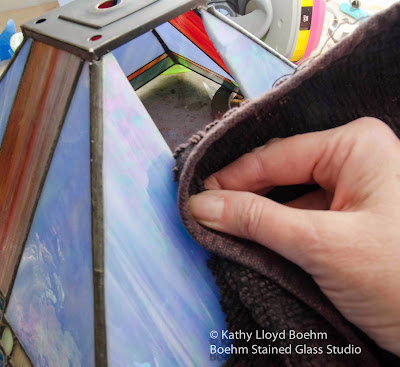Here is this colorful lamp, as its been sitting for the past ten years. It was covered with old flux and the original numbers, in silver and black indelible pen, were still clearly visible. The exterior of the dome had been lightly soldered .. The interior had been fully soldered.
Here I've sprayed the interior with Kwik-Clean and am wiping off accumulated flux and dust.
Removing the old flux from the outside of the dome, and removing the numbers, took several rounds of cleanser along with brushing and rubbing to remove it all.
This lamp held up very well over the years. Only one piece of glass on the edge, shown, needed to be replaced. Once I got the lamp reasonably clean, I re-soldered it in place after I removed the old foil and solder which surrounded it.
There were several areas which had exposed copper foil which had oxidized over the years. Here I'm using fine gauge steel wool to shine it up and prepare it for soldering.
Since the outside of the dome had only been lightly soldered, I went around the dome and beefed up the majority of the solder lines using the same 60/40 solder as was used originally.
An important part of lamp construction is the wire which generally is soldered onto the outer border. Since this lamp was never completed, I added the wire. First I scrubbed down the surface edge of the border pieces with steel wool.
Then I taped down a few inches of thin wire at a time, using blue painter's tape as shown. I centered the wire on the edge of each piece, then I soldered it in place.
Below, I've soldered the wire onto the border in sections. Some are done, a few are not. Eventually the entire border received the wire reinforcement. This will add years of life to the dome.
Next, I turned my attention to the cap. I removed the old solder, foil and flux which was on the inner border. Then I lightly filed the entire edge, as shown below.
In order to have the cap be totally secured, I added new copper foil, this time in 1/4" for better coverage on the sides.
My customer's daughter chose this beautiful cap which is well ventilated for the heat generated by the bulbs. I've added 1/4" copper foil to the edge of the cap.
Seen from the inside of the dome, I soldered the cap to the lamp and added in several lengths of flat, braided reinforcement wire. Some of the reinforcement runs in a circular path around the cap. Others run from the cap to the edge of the pale blue glass, along the lead lines. This will ensure that the cap will remain firmly bonded and secure.
Below, I'm applying Novacan Black Patina to the exterior of the lamp. It is brushed on with an acid brush and works instantly. Once the lamp is patinaed, it gets a full cleaning with Kwik-Clean spray.
Even after several cleanings, some residue remains, so I saturated several cotton balls with Goo Gone and removed the remainder of the flux and excess chemicals. My intent was to apply black patina to the interior of the dome. I purchased a 2" round brass brush (actually an attachment for a drill), but even with repeated brushings, the old solder would not accept the black patina. This will not affect the esthetics or the luminosity of the lamp. I simply waxed the interior of the lamp to protect the solder. I also applied wax to the outer dome and the cap.
As I was soldering the cap, some solder inevitably creeped onto the brass. As those who work with solder know, its virtually impossible to remove once it bonds with the metal. Therefore, I tinned the entire cap and applied black patina to it, so that it matches the overall look of the lamp.
And finally, after ten long years, this beautiful lamp is in use, and its true beauty can be seen. I can't wait for the owner and her daughter to see it and enjoy it!
Here's the view from above the lamp, showing all the gorgeous colors chosen for the lamp. Great job here, Marlene! Thanks so much for finding me, and for the wonderful stained glass supplies you gave me. Everything has found a place. Each time I use the supplies you and Sharon gave me, I'll be feeling very grateful! Happy Thanksgiving!
Please visit my website to see my custom windows and repairs (click here). And if you are on FaceBook, become a fan and I'll keep you up to date on all my stained glass projects. Call me any time at 201-600-1616 or email with your questions. Thanks!



























































